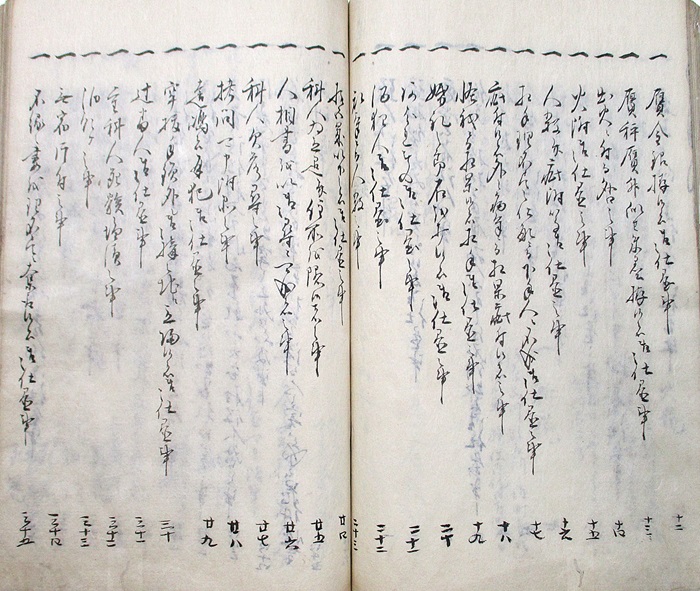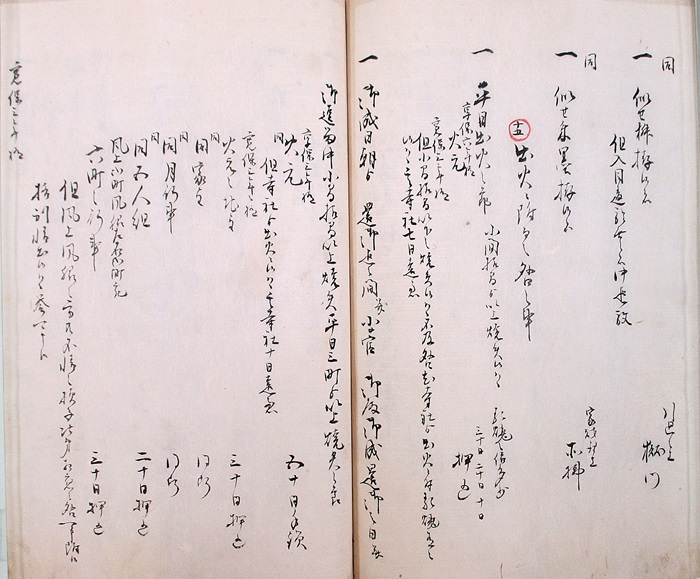
Protecting
Firefighters
Japan's first firefighting system was established during the Edo period (1603-1868). The main elements of the system were town firefighting squads formed by ordinary townsfolk, squads organized by the hatamoto (direct retainers of the Shogun), and squads organized by the daimyō (feudal lords).
- Town Firefighter Flags and Uniforms
- Tokyo Shiryō Collection 634-D5
-
"Town firefighters" was the term used to refer collectively to the Iroha 48 Squads and the Honjo Fukagawa 16 Squads, which fought fires in downtown Edo. They originated in 1718, when Ōoka Tadasuke, a Shogunate commissioner responsible for the town of Edo, ordered the formation of a fire crew to protect the town.
-



- Guide to Firefighting Flags in Edo
- Tokyo Shiryō Collection 634-23
-
This guidebook introduces the Iroha 48 Squads of town firefighters. The main firefighting method used at the time was to destroy the buildings to ensure the fire would not spread, and this work was performed by construction workers.
- Edo's Top Dandies Iwai Hanshirō
- Tokyo Shiryō Collection 644-13-7
-

- Edo's Top Dandies Ichikawa Danjūrō
- Tokyo Shiryō Collection 644-13-4
-

- Edo's Top Dandies Onoe Kikugorō
- Tokyo Shiryō Collection 644-13-1
-

This colored woodblock print depicts a popular actor dressed as a firefighter from the Iroha 48 Squads. A town firefighter holding his flag in a shower of sparks became a symbol of the Edo townsfolk.
- Parody of a Quarrel Among Firefighters
- Tokyo Shiryō Collection 4752-92
-

- Column
-
This is a kibyōshi (literally "yellow cover"), a type of illustrated storybook for adult readers. This kibyōshi, written by the playwright Shikitei Sanba, is a parodical depiction of a fight that had broken out during the previous year's Sannō Festival between members of the number one and number two town firefighting squads.
- Emblems of the Edo Firefighters
- Tokyo Shiryō Collection 6177-1
-
In 1658, the year after the Great Fire of Meireki, a permanent firefighting force was organized under the direct control of the Shogunate. Hatamoto (direct retainers) were ordered to establish a network of fire stations surrounding Edo Castle.
- Illustrated Plan of the Yayosugashi Fire Station (400:3)
- Tokyo Shiryō Collection 634-29
-
This is a floor plan of the interior of the Yayosugashi Fire Station, one of the stations established by the Shogunate around Edo Castle. The hatamoto lived at the station with his family and oversaw various ranks of officials including the yoriki and dōsin, as well as the gaen firefighters who worked under their command.
-

- Fire Watchtower at the Yayosugashi Fire Station
- Tokyo Shiryō Collection 634-C6
-
This is an elevation drawing of the fire watchtower in the Yayosugashi Fire Station. This watchtower was positioned higher than those used by ordinary townsfolk to spot fires. Even if one of the townsfolk's watchtowers spotted a fire first, they were not permitted to ring their own fire bell until the Fire Station drum was beaten.
-

- Oshichi, the Greengrocer's Daughter
- Tokyo Shiryō Collection N215-1
-

- Column
-
This colored woodblock print depicts Oshichi, the daughter of a greengrocer who was executed for arson in 1683. Various adaptations were made of Oshichi's story, including for Jōruri and Kabuki theater. One of the most famous scenes was that of Oshichi sounding the fire bell (or drum) at the fire watchtower. The story became standard subject matter for artists.
- The Kaga Squad at their Daimyō Mansion
- Tokyo Shiryō Collection M648-10-2
-
The daimyō firefighters were one of the two samurai firefighting forces, engaged by daimyō to protect important locations. This image shows the Kaga Squad of daimyō firefighters, which dressed in flamboyant uniforms and fought fires in locations such as the Yushima Seidō.
-

Bugyō (Shogunate Commissioners)
Bugyō were officials appointed by the Shogunate, and the so-called three bugyō types were jisha bugyō (commissioners of temples and shrines), machi bugyō (commissioners of judicial problems), and kanjō bugyō (commissioners of finance). When used alone, the term bugyō usually referred to the commissioners of judicial problems.
- 100 Judicial Precedents
- Tokyo Shiryō Collection 623-10
-
This text is from Collection of Judicial Precedents, a compilation of judicial precedents initiated in 1742. This was the first such compilation produced by the Edo Shogunate. On the order of the eighth Shogun Tokugawa Yoshimune, a committee comprising the three types of Shogunate commissioners worked on the compilation under the direction of Matsudaira Norisato.
- Map of Daimyō-koji Street Near Tatsunokuchi
- Collection of Special Acquisitions(from various individuals) 4306-1
-
This map covers the districts now known as Otemachi, Marunouchi, and the Imperial Palace forecourt. The central governmental organs of the Edo Shogunate were located near the Tatsunokuchi gate of Edo Castle. The castle is represented by the family crest of the Tokugawas.
-

- Ōoka's Judicial Cases: The Ten'ichibō Affair
- Tokyo Shiryō Collection M347-43-2
-
Ōoka Tadasuke was a renowned commissioner of judicial problems. His most famous cases were depicted in this series of stories, which was adapted into Kabuki plays, Kōdan historical storytelling, and storybooks. The judgments handed down by Ōoka in these stories were known as Ōoka sabaki (Ōoka's rulings), which became a synonym for celebrated judgments.
Note: Historical evidence shows that the judgment in the Ten'ichibō Affair mentioned in the title was actually delivered by a different person. -

 文化財ウィーク
文化財ウィーク










